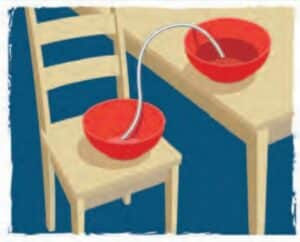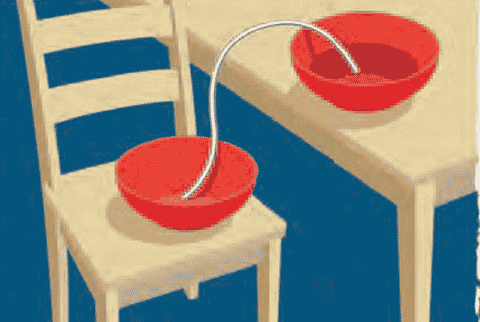Overview
STEM careers
Topic
Time
Materials
Per Class Team:
- 2 large bowls or containers, NOT glass
- 1 length plastic tubing, 2.5’–3′
- Table
- Chair
Instructions
Students discover how to make water flow upward without any extra force by creating a siphon pump.
- Fill a large bowl with water and place it on the edge of a desk or table. Set the second bowl on a chair next to the desk or table.
- Put one end of the tubing in the bowl of water. Raise and lower the other end over the second bowl, creating an arch in the tubing, with the second bowl lower than the first. Nothing will happen; there is nothing in the tubing and nothing to make fluid flow.

- Keep the first end of the tubing submerged. Gently suck
on the other end until water fills the tube. Cap the end with your thumb and quickly bring it down over the second bowl. Uncap the end. Water will flow into the second bowl. - Tell students to raise and lower the second end of the tube. They should notice:
- The lower the second end is from the water level in the first bowl, the faster the water will flow.
- If the second end of tubing is raised above the water level in the first bowl, the water will run back down the tubing into the first bowl and flow will cease. Students will have to reapply suction to get the flow started again.
- As water is flowing from the first to the second bowl, put both ends of tubing under water. Lift the second bowl to be higher than the first. The flow will reverse and go back into the first bowl.
Guiding questions
-
If the tubing were thicker, how would the water flow be affected?
-
If the tubing were longer, how would the water flow be affected?
-
What happens if the bowls are at the same level?
-
How steep an incline can you make the water travel up, as long as flow is initiated and the second end of tubing is lower than the water level of the source?
-
What might be some practical uses for siphons?
Engineering & science connections
- Engineers use pumps to deliver a liquid or gas, known as fluids, at a required rate. A pump changes the elevation, velocity, and/or pressure of a fluid.
- Pumps deliver a required amount of fluid, measured as a volume, in a given time, measured in seconds, minutes, or hours. The volume flow rate is a measure of how much fluid is delivered in a specific time.
- A siphon is a tube or pipe that uses gravity to have liquid flow from a higher level at one end to a lower level at the other end. But only the height of each siphon end point matters—between the end points, liquids or gases will flow uphill for part of the distance without added force. There are many practical uses for siphons, some of which include: pulling water from ditches and channels when irrigating fields, removing water from flooded homes, and even cleaning fish aquariums. One of the most common everyday uses of a siphon is the flush toilet—just using gravity, the waste travels upwards through an s-curve before traveling down into the drainage system.
- A siphon can be used to remove impurities from a liquid, because the liquid can be moved without transferring impurities that have settled to the bottom or floated to the top of its container. Sometimes municipalities use siphoning as one step in treating their wastewater.
This activity based on “PUMPS,” from the Society of Women Engineers. Developed in collaboration with Education Development Center, Inc.


0 Comments